Everyday Mathematics 6th Grade Answer Key Unit 3 Decimal Computation and Percents
Everyday Math Grade 6 Home Link 3.1 Answer Key
Reviewing Place Value with Decimals
Question 1.
Record two decimals that are equivalent to each decimal below.
a. 0.2 ____
Answer:
The two decimals that are equivalent to 0.2 = 0.20 and 0.200.
Explanation:
In the above-given question,
given that,
The decimal is 0.2.
0.2 = 0.20.
0.2 = 0.200.
so the the two decimals that are equivalent to 0.2 = 0.20 and 0.200.
b. 0.13
Answer:
The two decimals that are equivalent to 0.13 = 0.1 and 0.11.
Explanation:
In the above-given question,
given that,
The decimal is 0.13.
0.13 = 0.1.
0.13 = 0.11.
so the the two decimals that are equivalent to 0.13 = 0.1 and 0.11.
c. 2.145
Answer:
The two decimals are equivalent to 2.145 = 2.143 and 2.144.
Explanation:
In the above-given question,
given that,
The decimal is 2.145.
2.145 = 2.143.
2.145 = 2.144.
so the the two decimals that are equivalent to 2.145 = 2.143 and 2.144.
d. 7.06
Answer:
The two decimals are equivalent to 7.06 = 7.006 and 7.0006.
Explanation:
In the above-given question,
given that,
The decimal is 7.06.
7.06 = 7.006.
7.06 = 7.0006.
so the the two decimals that are equivalent to 7.06 = 7.006 and 7.0006.
Question 2.
Compare using <, >, or =.
a. 0.05 ___ 0.050
Answer:
0.05 = 0.050.
Explanation:
In the above-given question,
given that,
compare the decimals.
0.05 = 0.050.
0.05 is equals to 0.050.
b. 0.05 __ 0.5
Answer:
0.05 < 0.5.
Explanation:
In the above-given question,
given that,
compare the decimals.
0.05 < 0.5.
0.05 is less than 0.5.
c. 0.503 ___ 0.53
Answer:
0.503 < 0.53.
Explanation:
In the above-given question,
given that,
compare the decimals.
0.503 < 0.53.
0.503 is less than 0.53.
Question 3.
Explain why the zeros are necessary in 10.03 but not in 0.350.
Answer:
Question 4.
Circle the numbers that are equivalent.
![]()
Answer:
The numbers that are equivalent is 0.21 and 0.210.
Explanation:
In the above-given question,
given that,
circle the numbers that are equivalent.
0.21 = 0.210.
so the numbers that are equivalent is 0.21 and 0.210.

Question 5.
Cross out the names that do not belong. Add two names to each box.
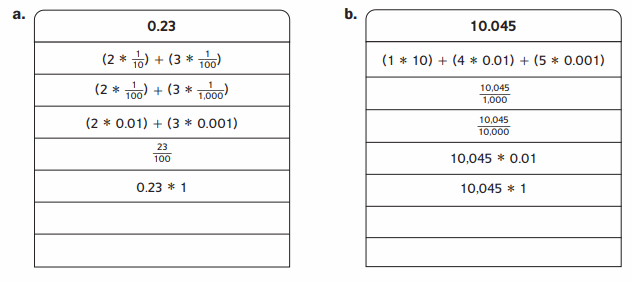
Answer:
a. 0.23 = 23/100.
b. 10.045/1000.
Explanation:
In the above-given question,
given that,
0.23 and 10.045.
0.23 = 23/100.
10.045 = 10.045/1000.
Practice
Question 6.
6 ÷ \(\frac{1}{2}\) = 7
Answer:
6 ÷ 1/2 = 12.
Explanation:
In the above-given question,
given that,
6 ÷ 1/2.
1/2 = 0.5.
6 ÷ 0.5 = 12.
Question 7.
2 ÷ \(\frac{1}{4}\) = ___
Answer:
2 ÷ 1/4 = 8.
Explanation:
In the above-given question,
given that,
2 ÷1/4.
1/4 = 0.25.
2 ÷ 0.25 = 8.
Question 8.
5 ÷ \(\frac{1}{3}\) = ___
Answer:
5 ÷ 1/3 = 15.1.
Explanation:
In the above-given question,
given that,
5 ÷ 1/3.
5 ÷ 0.33.
5 ÷ 0.33 = 15.1.
Everyday Mathematics Grade 6 Home Link 3.2 Answers
Decimals on the Number Line
Fido the flea is at it again. He starts at 0 and wants to go to the Flea Fair at 0.28 on the number line. Hop Set 1 takes a total of 10 hops to reach 0.28. Hop Set 2 takes a total of 28 hops to reach 0.28. Remember that the size of Fido’s hops are
always 1 tenth, 1 hundredth, or 1 thousandth.
Question 1.
Show the two different hop sets on the number lines below.
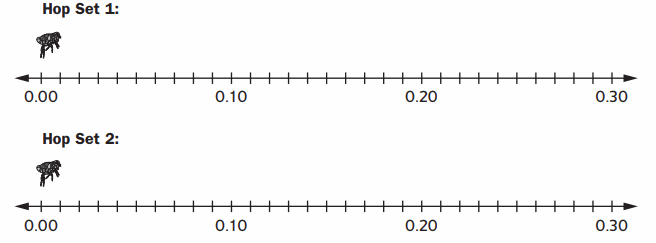
Answer:
The two different hop sets are : a. 0.18 b. 0.08.
Explanation:
In the above-given question,
given that,
Hop Set 1 takes a total of 10 hops to reach 0.28. Hop Set 2 takes a total of 28 hops to reach 0.28.
10 + 0.18 = 0.28.
20 + 0.08 = 0.28.
so the two different hop sets are 0.18 and 0.08.
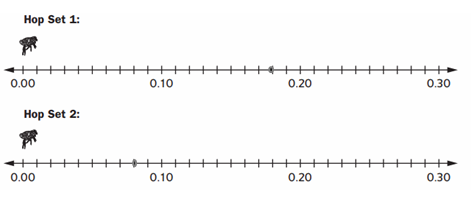
Question 2.
Write a number sentence to represent each hop set to 0.28.
Hop Set 1: _______________
Hop Set 2: _____________
Answer:
10 + 0.18 = 0.28.
20 + 0.08 = 0.28.
Explanation:
In the above-given question,
given that,
the number sentence to represent each hop set to 0.28.
10 + 0.18 = 0.28.
20 + 0.08 = 0.28.
Question 3.
a. Write 3.48 in expanded form as the sum of multiplication with decimals.
______________
Answer:
3 + 0.4 + 0.08.
Explanation:
In the above-given question,
given that,
3.48.
(3 x 1) + (4 x 1/10) + (8 x 1/100).
3 + 0.4 + 0.08.
b. Write a number between 3.48 and 3.49.
Answer:
3.489.
Explanation:
In the above-given question,
given that,
the number between 3.48 and 3.49.
3.48 = 3.489.
so the number between 3.48 and 3.49 is 3.489.
c. Explain how the expanded form of the number you wrote for Part b would be similar to the expanded form of 3.48 you recorded for Part a.
Answer:
3 + 0.4 + 0.08 + 0.009.
Explanation:
In the above-given question,
given that,
3.489.
(3 x 1) + (4 x 1/10) + (8 x 1/100) + ( 9 x 1/1000).
3 + 0.4 + 0.08 + 0.009.
Question 4.
Circle the numbers below that are between 8.032 and 8.033.
![]()
Answer:
The numbers are between 8.032 and 8.033 =
Explanation:
In the above-given question,
given that,
the numbers are 8.032 and 8.033.
8.0329, 8.03222, 8.023.
so the numbers are between 8.032 and 8.033 = 8.0329, 8.0322, and 8.023.
Practice
Insert <, >, or = to make each number sentence true.
Question 5.
3.4 ___ 3.40
Answer:
3.4 = 3.40.
Explanation:
In the above-given question,
given that,
compare the numbers.
3.4 = 3.40.
3.4 is equal to 3.40.
Question 6.
17.062 ___ 17.006
Answer:
17.062 = 17.006.
Explanation:
In the above-given question,
given that,
compare the decimals.
17.602 = 17.006.
17.602 is equal to 17.006.
Question 7.
12.405 ___ 12.41
Answer:
12.405 < 12.41.
Explanation:
In the above-given question,
given that,
compare the decimals.
12.405 < 12.41.
12.41 is greater than 12.405.
Everyday Math Grade 6 Home Link 3.3 Answer Key
Great Accomplishments in Sports
Question 1.
Geoffrey Mutai (Kenya) set the record for the New York City Marathon in 2011. His time was 2 hours, 5.10 minutes.
In 2013, he won the marathon again with a time of 2 hours, 8.40 minutes.
How much faster was Mutai’s time in 2011 than in 2013? _____________
Answer:
The faster was Mutai’s time in 2011 than in 2013 = 3.30 minutes.
Explanation:
In the above-given question,
given that,
In 2011, his time was 2 hours, 5.10 minutes.
In 2013 his time was 2 hours, 8.40 minutes.
40 – 10 = 30.
8 – 5 = 3.
3.30 minutes.
so the faster was Mutai’s time in 2011 than in 2013 = 3.30 minutes.
Question 2.
At the 1908 Olympics, Erik Lemming (Sweden) won the javelin throw. He threw the javelin 54.82 meters. He won again in 1912 with a throw of 60.64 meters.
How much longer was his 1912 throw than his 1908 throw? ____
Answer:
so the length was his 1912 throw than his 1908 throw = 5.82 meters.
Explanation:
In the above-given question,
given that,
At the 1908 Olympics, Erik lemming(Sweden) won the javelin throw.
He threw the javelin 54.82 meters.
He won again in 1912 with a throw of 60.64 meters.
60.64 – 54.82.
5.82.
so the length was his 1912 throw than his 1908 throw = 5.82 meters.
Question 3.
At the 1984 Olympics, Gregory Louganis (United States) won a gold medal in men’s springboard diving.
To calculate a diver’s final score, the average scores from 11 dives are added.

What was Louganis’s winning final score? ________
Answer:
The Louganis’s winning final score = 754.41.
Explanation:
In the above-given question,
given that,
the average scores from 11 dives are added.
47.52 + 53.01 + 44.16 + 40.32 + 68.88 + 81.00 + 85.56 + 77.40 + 71.1 + 93.06 + 92.40.
754.41.
so the Louganis’s winning final score = 754.41.
Question 4.
Driver Buddy Baker (Oldsmobile, 1980) holds the record for the fastest winning speed in the Daytona 500. His speed was 177.602 miles per hour. Bill Elliott (Ford, 1987) has the second-fastest winning speed. Elliott’s speed was 1.339 miles per hour slower than Baker’s speed.
What was Elliott’s speed? _______
Answer:
The speed of Elliott’s = 176.263 miles per hour.
Explanation:
In the above-given question,
given that,
Daytona speed was 177.602 miles per hour.
Elliott’s speed was 1.339 miles per hour slower than Baker’s speed.
177.602 – 1.339 = 176.263 miles.
so the speed of the Elliott’s = 176.263 miles per hour.
Practice
Question 5.
\(\frac{4}{5}\) ÷ \(\frac{1}{2}\) = ____
Answer:
4/5 ÷ 1/2 = 1.6.
Explanation:
In the above-given question,
given that,
4/5 ÷ 1/2.
4/5 = 0.8.
1/2 = 0.5.
0.8 ÷ 0.5 = 1.6.
Question 6.
\(\frac{3}{4}\) ÷ \(\frac{2}{3}\) = ______
Answer:
3/4 ÷ 2/3 = 1.13.
Explanation:
In the above-given question,
given that,
3/4 ÷ 2/3.
3/4 = 0.75.
2/3 = 0.66.
0.75 ÷ 0.66 = 1.13.
Question 7.
\(\frac{5}{6}\) ÷ \(\frac{1}{4}\) = ________
Answer:
5/6 ÷ 1/4 = 4.
Explanation:
In the above-given question,
given that,
5/6 ÷ 1/4.
5/6 = 0.8.
1/4 = 0.2.
0.8 ÷ 0.2 = 4.
Question 8.
\(\frac{2}{3}\) ÷ \(\frac{3}{4}\) = ______
Answer:
2/3 ÷ 3/4 = 1.6.
Explanation:
In the above-given question,
given that,
2/3 ÷ 3/4.
2/3 = 0.6.
3/4 = 0.75.
0.6 ÷ 0.75 = 1.6.
Everyday Math Grade 6 Home Link 3.4 Answer Key
Decimal-Multiplication Review
Use estimation to solve Problems 1–2.
Question 1.
Carlos is building a flower bed that is 13.2 m by 6.75 m. When he multiplied, Carlos got 89100.
Show where he should place the decimal point _______
Answer:
13.2 x 6.75 = 89.1
Explanation:
In the above-given question,
given that,
Carlos is building a flower bed that is 13.2 m by 6.75 m.
13.2 x 6.75.
89.1.
so he should place the decimal point before 1.
Question 2.
Stephanie says 1.95 ∗ 6.6 = 12.87.
Dante says the answer is 128.7. Who is right? Explain how an estimate might help you decide.
Answer:
Stephanie was correct.
Explanation:
In the above-given question,
given that,
Stephanie says 1.95 x 6.6 = 12.87.
Dante says the answer is 128.7.
1.95 x 6.6 = 12.87.
so Stephanie was correct.
For Problems 3–5, record a number sentence to show how you estimated. Then use the U.S. traditional multiplication algorithm to solve. Use your estimate to check your work.
Question 3.
3.4 ∗ 3.29
Estimate: ___
Answer: ___
3.4 x 3.29 = 11.186.
Explanation:
In the above-given question,
given that,
3.4 x 3.29.
3.4 x 3.29 = 11.186.
Question 4.
70.1 ∗ 4.8
Estimate: _____
Answer: ______
70.1 x 4.8 = 336.48.
Explanation:
In the above-given question,
given that,
70.1 x 4.8.
70.1 x 4.8 = 336.48.
Question 5.
Mr. Murphy is building a fence. He bought 7 packages of wooden fencing. One package costs $56.45. How much do they cost all together?
Estimate: ___
Number model: ___ Solution: ___
Answer:
The cost all together = $395.15.
Explanation:
In the above-given question,
given that,
Mr. Murphy is building a fence.
He bought 7 packages of wooden fencing.
One package costs $56.45.
$56.45 x 7 = 395.15.
so the cost of all together = $395.15.
Try This
Question 6.
Dr. Goode prescribes 0.2 gram of cold medicine for Donald. This medicine comes in tablets that are 0.05 gram or 0.5 gram. Should Donald take 4 of the 0.5 gram tablets or 4 of the 0.05 gram tablets? ____
How do you know? ___
Practice
Compare with >, <, or =
Question 7.
-7 ___ -3
Answer:
-7 > -3.
Explanation:
In the above-given question,
given that,
compare the numbers.
-7 and -3.
-7 > -3.
Question 8.
4 ___ -4
Answer:
4 > -4.
Explanation:
In the above-given question,
given that,
compare the numbers.
4 and -4.
4 > -4.
Question 9.
0 __ -3
Answer:
0 > -3.
Explanation:
In the above-given question,
given that,
compare the numbers.
0 and -3.
0 > -3.
Question 10.
-2 __ -5
Answer:
-2 < -5.
Explanation:
In the above-given question,
given that,
compare the numbers.
-2 and -5.
-2 < -5.
Everyday Math Grade 6 Home Link 3.5 Answer Key
Long Division
Solve each problem.
Write a number sentence to show how you checked your answer.
Question 1.
![]()
Check: ______
Answer:
38 / 966 = 16.
Explanation:
In the above-given question,
given that,
38/966.

Question 2.
![]()
Check: ______
Answer:
43/5938 =
Explanation:
In the above-given question,
given that,
43/5938.
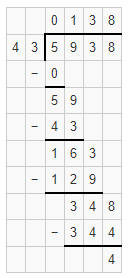
Fill in the missing numbers.
Question 3.
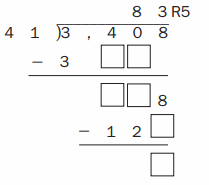
Answer:
41 / 3.408 = 5.
Explanation:
In the above-given question,
given that,
fill in the missing numbers.
41/3.408.
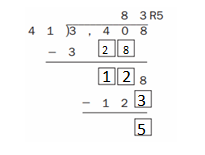
Question 4.
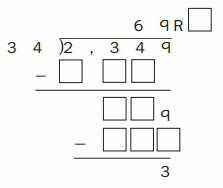
Answer:
34/2.349 = 3.
Explanation:
In the above-given question,
given that,
fill in the missing boxes.
34/2.349.
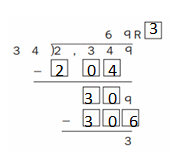
Question 5.
There are about 1,575 beads in a large economy-size tub at the craft store.
There are 49 different colors.
If the colors are distributed equally, about how many beadsof each color are there? ____
Answer:
The number of beads are shared equally = 33.
Explanation:
In the above-given question,
given that,
There are about 1,575 beads in a large economy-size tub at the craft store.
there are 49 different colors.
49 x 33 = 1575.
so the number of beads are shared equally = 33 beads.
Question 6.
The book The Phantom Tollbooth by Norton Juster (Random House, 1961) has 42,156 words. It is 256 pages long.
On average, how many words are on each page? _____
Answer:
so the average number of words on each page = 166.
Explanation:
In the above-given question,
given that,
The book has 42,156 words.
it is 256 pages long.
256 x 166 = 42,496.
so the average number of words on each page = 166.
Practice
Question 7.
___ = \(\frac{3}{4}\) ∗ \(\frac{2}{3}\)
Answer:
3/4 x 2/3 = 0.45.
Explanation:
In the above-given question,
given that,
3/4 x 2/3.
3/4 = 0.75.
2/3 = 0.6.
0.75 x 0.6 = 0.45.
3/4 x 2/3 = 0.45.
Question 8.
\(\frac{4}{5}\) ∗ \(\frac{1}{8}\) = ____
Answer:
4/5 x 1/8 = 0.1.
Explanation:
In the above-given question,
given that,
4/5 x 1/8.
4/5 = 0.8.
1/8 = 0.125.
0.8 x 0.125 = 0.1.
4/5 x 1/8 = 0.1.
Question 9.
9\(\frac{2}{7}\) ∗ \(\frac{3}{5}\) = ____
Answer:
9(2/7) x 3/5 = 5.5.
Explanation:
In the above-given question,
given that,
9(2/7) x 3/5.
7 x 9 = 63.
63 + 2 = 65.
65/7 x 3/5.
65/7 = 9.2.
3/5 = 0.6.
9.2 x 0.6 = 5.5.
Question 10.
___ =\(\frac{1}{3}\) ∗ \(\frac{2}{9}\)
Answer:
1/3 x 2/9 = 0.6.
Explanation:
In the above-given question,
given that,
1/3 x 2/9.
1/3 = 0.3.
2/9 = 0.2.
0.3 x 0.2 = 0.6.
Everyday Math Grade 6 Home Link 3.6 Answer Key
Question 1.
Put the decimal point in the correct position in each quotient. Use multiplication to check your answer.

Answer:
564 x 3.9 = 219.96.
Explanation:
In the above-given question,
given that,
564 x 3.9 = 219.96.
687 x 0.52 = 357.24.
345 x 6.8 = 2346.
87 x 1.95 = 169.65.

Divide and check.
Question 2.
![]()
Check: _______
Answer:
0.72/5.976 = 0.
Explanation:
In the above-given question,
given that,
divide.
0.72/5.976.

Question 3.
![]()
Check: _______
Answer:
1.6 / 7.712 =
Explanation:
In the above-given question,
given that,
divide.
1.6 / 7.712.
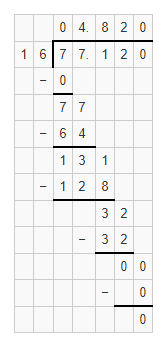
Question 4.
Jaime has 3 cups of berries. Each fruit-and-yogurt parfait he makes contains 0.4 cup of berries. How many parfaits can he make?
Number sentence: ____ Solution: ____
Check: ________
Answer:
The number of parfaits he can make = 7.5.
Explanation:
In the above-given question,
given that,
Jaime has 3 cups of berries.
Each fruit-and-yogurt parfait he makes contains 0.4 cups of berries.
3/0.4 = 7.5.
so the number of parfaits he can make = 7.5.
Practice
Question 5.
GCF (10, 3) = _____
Answer:
GCF of 10 and 3 = 1.
Explanation:
In the above-given question,
given that,
GCF of 10 and 3.
factors of 10 = 1, 2, 5, 10.
factors of 3 = 1, 3.
among those factors 1 is the common factor.
Question 6.
GCF (12, 24) = ____
Answer:
GCF of 12 and 24 = 12.
Explanation:
In the above-given question,
given that,
GCF of 12 and 24.
factors of 12 = 1, 2, 3, 4, 6, 12.
factors of 24 = 1, 2, 3, 4, 6, 8, 12, 24.
among those factors 12 is the greatest common factor.
Question 7.
GCF (100, 80) = ____
Answer:
GCF of 100 and 80 = 20.
Explanation:
In the above-given question,
given that,
GCF of 100 and 80.
factors of 100 = 1, 2, 4, 5, 10, 20, 25, 50, 100.
factors of 80 = 1, 2, 4, 5, 8, 10, 16, 20.
among those factors 20 is the greatest common factor.
Question 8.
GCF (18, 42) = ____
Answer:
GCF of 18 and 42 = 6.
Explanation:
In the above-given question,
given that,
GCF of 18 and 42.
factors of 18 = 1, 2, 3, 6, 9, 18.
factors of 42 = 1, 2 3, 6, 7, 14, 21, 42.
among those factors 6 is the greatest common factor.
Everyday Math Grade 6 Home Link 3.7 Answer Key
Decimal Operations
Margaret is making a pair of purple pajama pants for her daughter Marie.
To figure out how much purple fabric she needs, Margaret must do the following:
- Measure the length from Marie’s waist to her ankle.
- Double this measurement.
- Add 12 inches.
Question 1.
From waist to ankle, Marie measures 33 inches.
How many inches of the purple fabric does Margaret need? ____
Answer:
The purple fabric does Margaret needs = 78 inches.
Explanation:
In the above-given question,
given that,
from waist to ankle, Marie measures 33 inches.
33 + 33 = 66.
66 + 12 = 78 inches.
so the purple fabric does Margaret needs = 78 inches.
Question 2.
Cloth is sold in yards. How many yards of purple fabric will Margaret buy? Explain why your answer makes sense.
Answer:
so the number of yards of purple fabric will Margaret buy = 1.56 yds.
Explanation:
In the above-given question,
given that,
1 inch = 0.02 yds.
78 x 0.02 = 1.56.
so the number of yards of purple fabric will Margaret buy = 1.56 yds.
Question 3.
The purple fabric costs $5.50 per yard. The tax added to Margaret’s bill is $1.23. How much does Margaret spend on the fabric?
____ Show your work.
Answer:
The Margaret spend on the fabric = $6.73.
Explanation:
In the above-given question,
given that,
The purple fabric costs $5.50 per yard.
The tax added to Margaret’s bill is $1.23.
$5.50 + $ 1.23 = $6.73.
so the Margaret spend on the fabric = $6.73.
Question 4.
Margaret pays with a $20 bill. How much change does she receive? ___
Answer:
The change does she receive = $13.27.
Explanation:
In the above-given question,
given that,
Margaret pays with a $20 bill.
20 – 6.73 = $13.27.
so the change does she receive = $13.27.
Bring in examples of how percents are used in the world around us. You can write down, cut out, or print examples from newspapers, television, the Internet, and so on. We will collect these in a Percent Museum.
Practice
Find the LCM.
Question 5.
LCM (8, 12) = ____
Answer:
LCM of 8 and 12 = 24.
Explanation:
In the above-given question,
given that,
LCM of 8 and 12.
multiples of 8 = 8, 16, 24, 32, 40.
multiples of 12 = 12, 24, 36, 48.
among those 24 is the least common factor.
Question 6.
LCM (4, 14) = _____
Answer:
LCM of 4 and 14 = 28.
Explanation:
In the above-given question,
given that,
LCM of 4 and 14.
multiples of 4 = 4, 8, 12, 16, 20, 24, 28.
multiples of 14 = 14, 28, 42, 56.
among those 28 is the least common factor.
Question 7.
LCM (10, 15) = ____
Answer:
LCM of 10 and 15 = 30.
Explanation:
In the above-given question,
given that,
LCM of 10 and 15.
multiples of 10 = 10, 20, 30, 40, 50.
multiples of 15 = 15, 30, 45, 60.
among those 30 is the least common factor.
Question 8.
LCM (9, 12) = ____
Answer:
LCM of 9 and 12 = 36.
Explanation:
In the above-given question,
given that,
LCM of 9 and 12.
multiples of 9 = 9, 18, 27, 36.
multiples of 12 = 12, 24, 36, 48.
among those 36 is the least common factor.
Everyday Math Grade 6 Home Link 3.8 Answer Key
Question 1.
A recent survey investigated whether Summit Middle School students prefer to wear school uniforms. Here are the results:
- 63 percent prefer school uniforms.
- 32 percent do not prefer school uniforms.
- 5 percent do not have a preference.
Shade each percent on the grids below. Record the decimal and fraction equivalents.
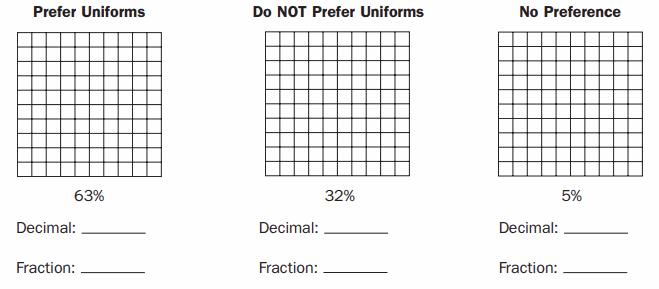
Answer:
Decimal = 0.63, 0.32, 0.5.
Fraction = 63/100, 32/100, 5/100.
Explanation:
In the above-given question,
given that,
63% prefer school uniforms.
32% do not prefer school uniforms.
5% no preference.
decimal = 0.63, 0.32, 0.5.
fraction = 63/100, 32/100, 5/100.

Question 2.
Teresa was designing a game to play at lunchtime with her friends. She wanted to know which number on a die is the luckiest. She rolled a die 50 times. The die landed showing the number five 20 times. She claimed she rolled a five 20% of the time.
a. Explain her mistake.
Answer:
b. For what percent of her 50 rolls did she roll a five?
Answer:
c. How did you get your answer for Part b?
Answer:
Practice
Question 3.
14.7 – 13.2 = ____
Answer:
14.7 – 13.2 = 1.5.
Explanation:
In the above-given question,
given that,
subtract.
14.7 – 13.2.

Question 4.
4.52 – 3.5 = ____
Answer:
4.52 – 3.5 = 1.02.
Explanation:
In the above-given question,
given that,
subtract.
4.52 – 3.5.
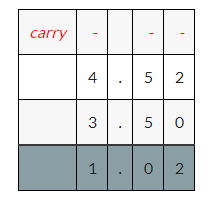
Question 5.
1.2 – 0.006 = ____
Answer:
1.2 – 0.006 = 1.194.
Explanation:
In the above-given question,
given that,
subtract.
1.2 – 0.006.
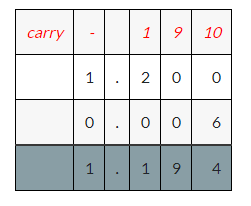
Question 6.
3.424 – 3.006 = ___
Answer:
3.424 – 3.006 = 0.418.
Explanation:
In the above-given question,
given that,
subtract.
3.424 – 3.006.
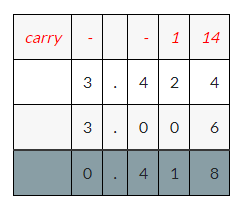
Everyday Math Grade 6 Home Link 3.9 Answer Key
Solving Percent Problems
Question 1.
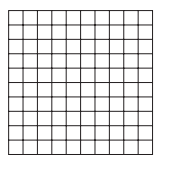
a. Shade in the grid to represent that 2 out of every 10 moviegoers buy their tickets ahead of time.
Answer
20/100.
Explanation:
In the above-given question,
given that,
2 out of every 10 moviegoers buy their tickets ahead of time.
2 – 10.
4 – 20.
6 – 40.
20 -100.
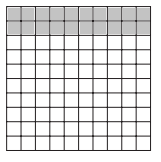
b. What fraction of moviegoers buy their tickets ahead of time?
Answer:
20/100.
Explanation:
In the above-given question,
given that,
2 out of every 10 moviegoers buy their tickets ahead of time.
2 – 10.
4 – 20.
6 – 40.
20 -100.
c. What percent of moviegoers buy their tickets ahead of time?
Answer:
0.2.
Explanation:
In the above-given question,
given that,
2 out of every 10 moviegoers buy their tickets ahead of time.
2 – 10.
4 – 20.
6 – 40.
20 -100.
d. If 200 people go to the movies, how many would buy their tickets ahead of time?
Answer:
Question 2.
a. Shade in the grid to represent that 11 out of every 20 people prefer watching movies at home instead of watching them at the theater.

b. What fraction of people preferto watch movies at home?
c. What percent of people prefer to watch movies at home?
d. If 60 people are asked, how many prefer to watch movies at home?
Answer:
11/20.
55%.
33.
Explanation:
In the above-given question,
given that,
11 people out of 20 watch movies at home.
11/20.
55 percent of people prefer to watch movies at home.
11 + 11 + 11 = 33.
![]()
Question 3.
a. 10% of 60:___
Answer:
10% of 60 = 0.16.
Explanation:
In the above-given question,
given that,
10% of 60.
10/60 = 0.16.
b. 25% of 80:
Answer:
25% of 80 = 0.31.
Explanation:
In the above-given question,
given that,
25% of 80.
25/80 = 0.31.
c. Explain how you found the answer to Part b.
Answer:
Question 4.
a. Write \(\frac{9}{10}\) as a percent. ____
Answer:
9/10 = 0.9.
Explanation:
In the above-given question,
given that,
9/10.
9/10 = 0.9.
b. Write \(\frac{2}{5}\) as a percent. _____
Answer:
0.04.
Explanation:
In the above-given question,
given that,
2/5.
2/5 x 100 = 0.04.
Practice
Find the median.
Question 5.
109, 121, 134, 115, 146 _____
Answer:
Median = 134.
Explanation:
In the above-given question,
given that,
Median of 109, 121, 134, 115, 146.
median = 134.
Question 6.
11, 17, 22, 13, 35, 27 _____
Answer:
Median = 17.5.
Explanation:
In the above-given question,
given that,
Median of 11, 17, 22, 13, 35, 27.
35/2 = 17.5.
Everyday Math Grade 6 Home Link 3.10 Answer Key
Percents as Ratios
Question 1.
Fill in the missing numbers and shade the grid.
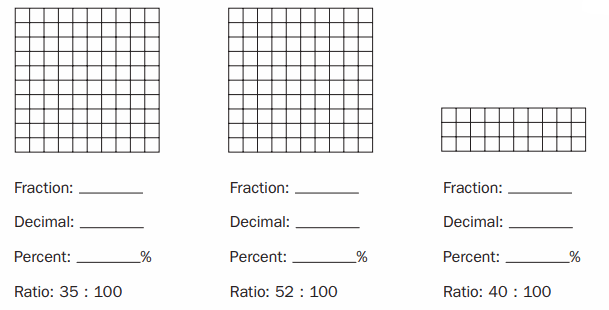
Use ratio/rate tables to solve each problem.
Answer:
Fraction = 35/100, 52/100, 40/100.
Explanation:
In the above-given question,
given that,
fraction = 35/100, 52/100, 40/100.
decimal = 0.35, 0.52, 0.40.
percent = 35%, 52%, 40%.
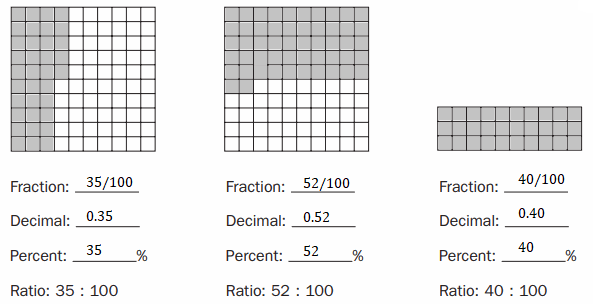
Question 2.
Kiese has read 80% of his library book. The book has 200 pages. How many pages has he read?
Answer:
The number of pages he has read = 0.4.
Explanation:
In the above-given question,
given that,
Kiese has read 80% of his library book.
The book has 200 pages.
80/200 = 0.4.
Question 3.
A bakery donated 30 loaves of bread to a homeless shelter. That was 25% of the loaves they made that morning. How many loaves did they
make that morning?
Answer:
The number of loaves they make that morning = 1.2.
Explanation:
In the above-given question,
given that,
A bakery donated 30 loaves of bread to a homeless shelter.
That was 25 % of the loaves they made that morning.
30/25 = 1.2.
Practice
Write an equivalent ratio.
Question 4.
2 : 3 ___
Answer:
Equivalent ratio of 2:3 = 40:55.
Explanation:
In the above-given question,
given that,
2/3 = 40:55.
Question 5.
5 : 6 ____
Answer:
Equivalent ratio of 5:6 = 10:12.
Explanation:
In the above-given question,
given that,
5 x 2 = 10.
6 x 2 = 12.
5 : 6 = 10:12.
Question 6.
3 : 9 ____
Answer:
Equivalent ratio of 3:9 = 6:18.
Explanation:
In the above-given question,
given that,
3 x 2 = 6.
9 x 2 = 18.
3 : 9 = 6 : 18.
Question 7.
14 : 20 ____
Answer:
Equivalent ratio of 14:20 = 28:40.
Explanation:
In the above-given question,
given that,
14 = 7 x 2.
20 = 10 x 2.
14 : 20 = 28: 40.
Everyday Math Grade 6 Home Link 3.11 Answer Key
Tiger Facts
Solve.
Question 1.
Tigers have a hunting success rate of about 10%. A tiger successfully hunts 4 times in one week. How many attempts did the tiger make?
Answer:
The number of attempts did the tiger make = 4%.
Explanation:
In the above-given question,
given that,
Tigers have a hunting success rate of about 10%.
A tiger successfully hunts 4 times in one week.
4%.
so the number of attempts did the tiger make = 4%.
Question 2.
A Bengal tiger’s tail is around 30% of its total length. The total length of one Bengal tiger’s tail is 96 cm. Around how long is the tiger?
Answer:
The length of the tiger = 3.2 cm.
Explanation:
In the above-given question,
given that,
A Bengal tiger’s tail is around 30% of its total length.
The total length of one Bengal tiger’s tail is 96 cm.
96/30 = 3.2
Question 3.
At the start of the 20th century, there were about 100,000 tigers in the wild. In 2014, there were about 3,200. By about what percent did the tiger population decrease?
Answer:
The population of the tiger = 96,800.
Explanation:
In the above-given question,
given that,
At the start of the 20th century, there were about 100,000 tigers in the wild.
In 2014, there were about 3,200.
100,000 – 3200.
96,800.
so the population decrease = 96,800.
Question 4.
Tiger cubs are around 2 years old when they leave their mothers. In the wild, tigers live about 11 years. About what percent of their lives
do tigers spend with their mothers?
Answer:
The percent of their lives do tigers spend with their mothers = 5.5%.
Explanation:
In the above-given question,
given that,
Tiger cubs are around 2 years old when they leave their mothers.
In the wild, tigers live about 11 years.
2/11 = 5.5.
so the percent of their lives do tigers spend with their mothers = 5.5%.
Try This
Question 5.
About 5,000 tigers live in captivity in the United States. About 10% of these tigers live in reputable zoos. Around how many of these tigers DO NOT live in reputable zoos?
Answer:
The tigers do not live in reputable Zoos = 500.
Explanation:
In the above-given question,
given that,
About 5000 tigers live in capacity in the United States.
About 10 % of these live in reputable zoos.
1000 – 10% = 100.
5000 – 10% = 500.
so the tigers do not live in reputable zoos = 500.
Practice
Compare using >, <, or =.
Question 6.
2.58 ___ 2.576
Answer:
2.58 > 2.576.
Explanation:
In the above-given question,
given that,
compare the decimals.
2.58 > 2.576.
2.58 is greater than 2.576.
Question 7.
\(\frac{5}{6}\) ___ \(\frac{8}{9}\)
Answer:
5/6 < 8/9.
Explanation:
In the above-given question,
given that,
compare the decimals.
5/6 = 0.83.
8/9 = 0.88.
0.83 < 0.88.
Question 8.
\(\frac{7}{8}\) ___ 0.875
Answer:
7/8 = 0.875.
Explanation:
In the above-given question,
given that,
compare the decimals.
7/8 = 0.875.
0.875 = 0.875.
Question 9.
\(\frac{4}{7}\) __ 0.59
Answer:
4/7 < 0.59.
Explanation:
In the above-given question,
given that,
compare the decimals.
4/7 = 0.57.
0.57 < 0.59.
Everyday Math Grade 6 Home Link 3.12 Answer Key
Box Plots
Fill in the blanks about a five-number summary you could use to make a box plot.
Question 1.
These five numbers divide the data into four ______.
Answer:
Question 2.
What can you NOT tell from a box plot? _____
Answer:
Use the box plot to answer the questions in Problems 3–5.

Question 3.
Half of the juniper leaves are longer than what measurement? ___
Answer:
The juniper leaves are longer than rose.
Explanation:
In the above-given question,
given that,
Hawthorn leaves = 5 cm.
Rose = 3 cm.
Juniper = 4.5 cm.
Question 4.
Which plant has the shortest leaves? How do you know?
Answer:
Rose has the shortest leaves.
Explanation:
In the above-given question,
given that,
Hawthorn leaves = 5 cm.
Rose = 3 cm.
Juniper = 4.5 cm.
Question 5.
Which type of leaf varies the most in length? ____
Use the box plot to answer the questions in Problems 6–7.

Answer:
Question 6.
The middle 50% of attendance at MLB stadiums is between ___ and ___ million people.
Answer:
Question 7.
Which quarter of the data has the greatest range? ____
Practice
Question 8.
If 50% of a number is 14, then 100% of the number is ____.
Answer:
The number is 28.
Explanation:
In the above-given question,
given that,
If 50% of a number is 14.
then 100% of the number = 28.
Question 9.
If 10% of a number is 6, then 100% of the number is ___.
Answer:
The number is 60.
Explanation:
In the above-given question,
given that,
if 10% of a number is 6.
then 100% = ?
100% is 60.
Everyday Math Grade 6 Home Link 3.13 Answer Key
Box Plots for Olympic Medals
Countries often win more than one medal at the Olympic games.
Nineteen countries won more than 12 medals each at the London Olympic games in 2012. Listed below are the numbers of medals won by each of those countries.
- Gold: 1, 3, 3, 5, 6, 6, 6, 7, 7, 7, 8, 8, 11, 11, 13, 24, 29, 38, 46
- Silver: 1, 2, 3, 4, 5, 5, 5, 6, 8, 9, 10, 11, 14, 16, 17, 19, 26, 27, 29
- Bronze: 4, 5, 5, 5, 6, 7, 8, 9, 9, 11, 12, 12, 12, 14, 17, 19, 23, 29, 32
Question 1.
List the five-number summary for each type of medal.
Gold: ___ Silver: ___
Bronze: ___
Answer:
Gold = 1, 3, 3, 5, 6.
Silver = 1, 2, 3, 4, 5.
Bronze = 4, 5, 5, 5, 6.
Explanation:
In the above-given question,
given that,
Gold = 1, 3, 3, 5, 6.
Silver = 1, 2, 3, 4, 5.
Bronze = 4, 5, 5, 5, 6.
Question 2.
Make a box plot for each type of medal: gold, silver, and bronze. Make all three box plots, one above the other, on the number line at right.
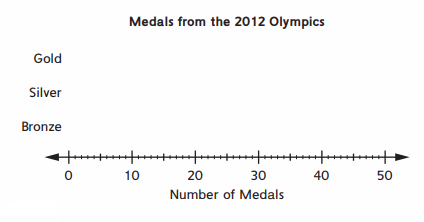
Answer:
Question 3.
List the IQR for each type of medal.
Gold: ___ Silver: ___ Bronze: ____
Answer:
Question 4.
What does the IQR tell you about the number of gold medals that were won?
Answer:
Practice
Find the equivalent unit ratio.
Question 5.
4 : 8
Answer:
Question 6.
5 : 15
Answer:
Question 7.
66 : 33
Answer:
Question 8.
56 : 14
Answer:
Everyday Math Grade 6 Home Link 3.14 Answer Key
Matching Histograms and Box Plots
Below are two histograms and two box plots.

Question 1.
Box Plot __ matches Histogram A.
Answer:
Question 2.
Box Plot __ matches Histogram B.
Answer:
Question 3.
Sketch each box plot above its corresponding histogram.
Answer:
Question 4.
Explain how you know which box plot matches the data shown in Histogram A.
Answer:
Question 5.
Explain how you know which box plot matches the data shown in Histogram B.
Answer:
Try This
Question 6.
The title Median Family Income by State (in thousands) matches Histogram ___.
Answer:
Question 7.
The title Percent of Adults with College Degrees by State matches Histogram ___.
Answer:
Practice
Divide.
Question 8.
4.2 ÷ 2.1 = ___
Answer:
4.2 /2.1 = 2.
Explanation:
In the above-given question,
given that,
divide.
4.2/2.1.
2.
Question 9.
36 ÷ 0.6 = ___
Answer:
36/0.6 = 60.
Explanation:
In the above-given question,
given that,
divide.
36/0.6 = 60.
Question 10.
0.15 ÷ 0.05 = ___
Answer:
0.15 /0.05 = 3.
Explanation:
In the above-given question,
given that,
divide.
0.15/0.05 = 3.